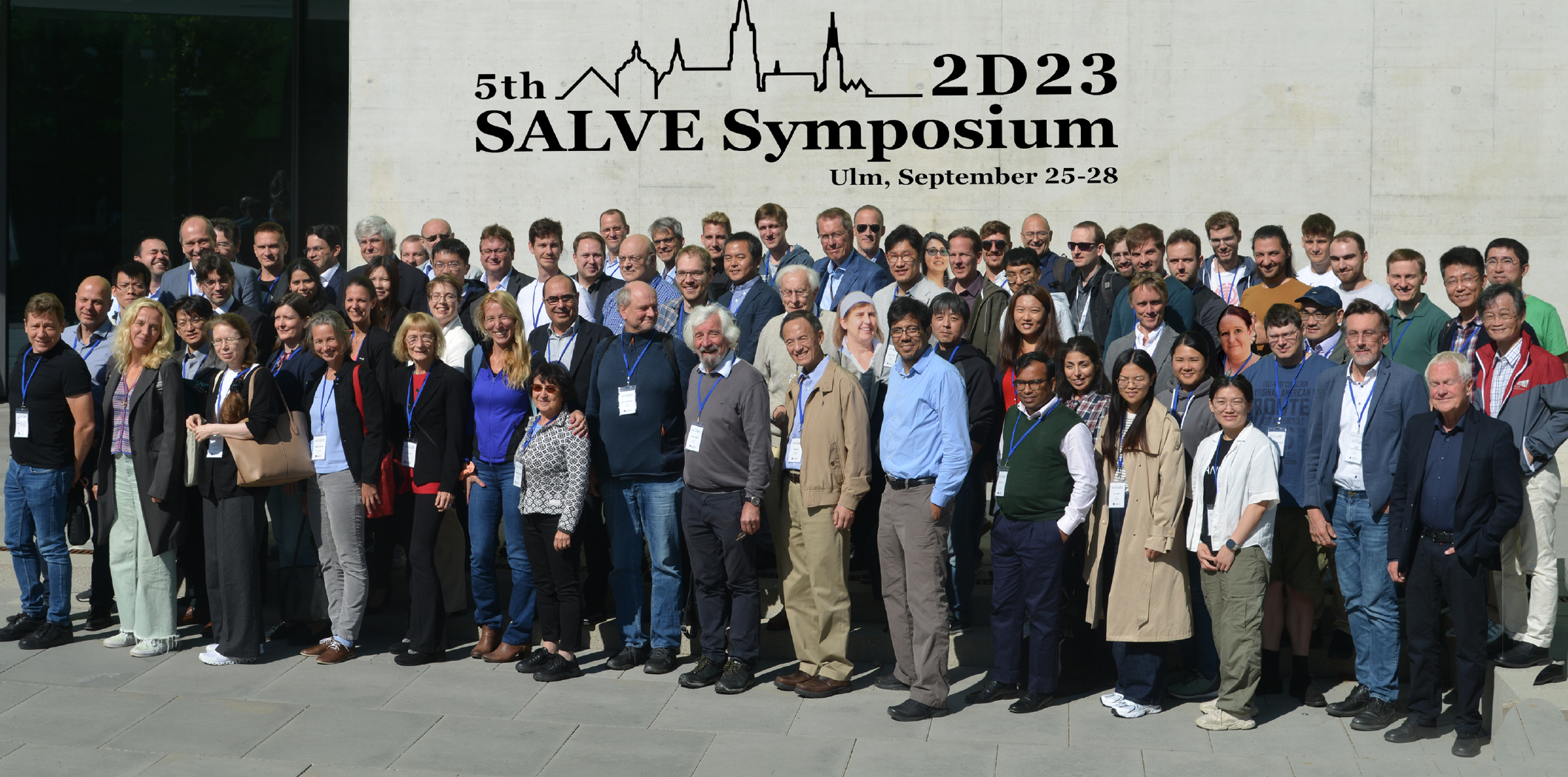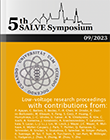Fifth SALVE symposium 2023 held at the University of Ulm
September 25-28, 2023 - The SALVE (Sub-Ångstrom Low Voltage Electron microscopy) Symposium 2023 (SALVE 2D23), organized by Ute Kaiser, was held from 25th to 28th of September at Ulm University. The symposium was attended, in total, by 111 participants from 16 countries, among those researchers, company representatives and many students. 14 scientific sessions included 48 scientific presentations given by invited speakers from Germany, Austria, Belgiun, China, Czechia, Denmark, France, Hong Kong, Israel, Japan, Korea, the Netherlands, Slovakia, Switzerland, the UK and the US. Latest results of the application of SALVE to topical research on 2D materials were presented also by posters displayed throughout the conference.

Figure 2: A snapshot of some participants of the SALVE Symposium 2023. Snapshots of the sessions and discussions are shown in Figs. 3-15.
In its relevance for exploring the new potentials of aberration-corrected electron microscopy, SALVE has a three-fold meaning: the name stands for new instrumentation, for a world-wide science community applying these instruments as well as for a series of conferences which carry SALVE in their title and which promote and enable the exchange of novel results and their applications in various fundamental and applied fields of materials physics and of materials science and engineering. The application of the SALVE instrumentation opened up completely new fields in science and is particularly beneficial for the atomic-scale structural and spectroscopic characterization of 2D materials and ultrathin layer systems as well as for the characterization of atomic defects that often determine the structural, electronic, optical, and mechanical properties. Research applying such investigations thus contributes also to the development of technology based on such materials.
The SALVE 2D23 Symposium on ‘Low-Voltage Atomically Resolved TEM / STEM for Low Dimensional Materials: Basics, Developments, Applications’ has proven to be a successful forum for presenting and discussing advances and novel research on structural and electronic defect properties in inorganic and organic low D materials and ultra-thin layer systems, on new preparation approaches, on recent quantum mechanical calculations of their properties, and on materials applications. Applying the strategy of bringing together researchers from physics, chemistry, biology, quantum-mechanical computation, and engineering, confirmed again, working in interdisciplinary projects, that many new scientific discoveries and technological developments can be found at the interfaces between the different disciplines. The symposium showcased again numerous examples documenting the impressive progress that has been made possible by applying aberration-corrected electron microscopy at low voltages to research and development for 2D and low-dimensional materials.
The symposium was organized by Prof. Dr. Ute Kaiser and her team from the Central Facility ‘Materials Science Electron Microscopy’ of Ulm University (Fig. 2). The conference took place in the lecture halls TTU and N27 of Ulm University. With its intention to show the latest developments, this 5th SALVE Symposium continued successfully the series of SALVE Symposia held before at the Universität Ulm (2013, 2015, 2017, 2022). Papers related to the symposium will be published in a special issue of Micron named Low-Dimensional Materials and Electron Microscopy.
Welcomed by the president Prof. Michael Weber of Ulm University and Prof. Ute Kaiser as symposium chair, the symposium started and participants discussed fundamental aspects, progress, future prospects and challenges, current developments and the latest scientific findings and ideas in different areas of their application to material physics and to materials science and engineering. The impressive progress is reflected by the broad range of topics presented by the invited speakers. In Session 1 and 2 Quo Vadis 2D materials in application (Li, HK), low-voltage TEM and low-dimensional materials (Kaiser, DE), BNC phases and 2D-3D structures (Ajayan, USA), electron microscopy and spectroscopy on 2D hybrid materials (Suenaga, JP), atomic resolution 3D dynamics of helix materials (Chen, HK), 2D electronics beyond silicon (Humphreys, UK).
In sessions 3 and 4 sculpting of 2D materials (Drndic, USA), in situ STEM and ptychography of 2D interfaces (Huang, USA), fabrication and analysis of 2D and mixed-dimensional heterostructures (Meyer, DE), quantifying atomic structures and their dynamics (Van Aert, BE), sample characterization and implantation in ultra-clean environment (Silvent, FR), CVD synthesis and properties of TMD (Turchanin, DE), STEM / EELS of molecular and atomic systems (Ramasse, UK) were presented.
In session 5 the presentations included optical properties of 2D materials (Konecna, CZ), quantum rings – electronic structure and packing behaviour (Besley, UK), observing atoms in motion (Koch, DE), chemical reactions promoted by the electron beam in TEM (Khlobystov, UK), synthesis mechanisms of novel CsPBr3@MoS2 nanostrucures (Yadgarov, ISR), organic nanomaterials by liquid phase exfoliation (Backes, DE).
The topics presented in session 6 and 7 were twisted Au nanoparticles in twisted MoS2 bilayers (Sinclair, USA), graphene folding and fabrication of twisted layer graphene (Willinger, DE), cryo-STEM/EELS for 1D and 2D materials (Klie, USA), engineering structure and properties of 2D materials by defect creation and intercalation (Krasheninnikov, DE), future prospects of aberration correctors for STEM (Linck, DE), advances of momentum resolved EELS (Pichler, AT), achromatic imaging of EELS and EMCD with atomic plane resolution (Zhong, HK), gradient based analysis and design of momentum-resolved STEM experiments (Müller-Caspary, DE).
In sessions 8 and 9 teh presentations included emerging EM techniques for probing quantum materials (Zhu, USA), upscaling electron beam manipulation of graphene impurities (Susi, AT), in situ TEM on 2D ferroic chalcogenides (Zhao, HK), graphene nanopores (Schneider, NL), 3D and 4D structures of colloidal nanoparticles by graphene liquid cell TEM (Park, KOR), superlubric sliding in bilayer graphene (Spiecker, DE).
The topics of sessions 10 and 11 were EELS at extreme losses (Lazar, NL), single atom microscopy and spectroscopy for C nanomaterials (Zhou, CN), charge transport and photovoltaic performance of strained III-V nanowires (Jäger, DE), STEM of graphene, B-N and TMD 2D materials (Idrobo , USA), imaging beam-sensitive materials with direct detection cameras (Gorji, DE), 2D electron gases at oxide interfaces (Stöger-Pollach, AT), 2D metal iodide-graphene heterostructures (Skakalova, SK), nanofluidic EM (Molhave, DK).
And in the final sessions 12 and 13 the presentations covered the topics atomic resolution EM in magnetic field free environment (Mukai, DE), quantitative low-energy coherent electron beam imaging and CBED of 2D materials (Latychevskaia, CH), creating and imaging quantum centers in diamond 2D materials (Kotakowski, AT), advances in organic 2D crystals (Feng, DE), advances in biological Cryo-EM by STEM (Elbaum, ISR), TOMO project integrating a fully functional atom probe in an aberration-corrected TEM (Mayer, DE), and advanced TEM of 2D magnetic materials (Dunin-Borkowski, DE).
In view of the importance for understanding the relationship between material properties and microstructure, novel research was reported from areas such as quantum physics, energy technology, nanotechnology, nanoelectronics, information technology, biology, transport, novel instrument and method development, and environmental research. Concluding this scientific part of the symposium, Rafal Dunin-Borkowski (ER-C Jülich, Germany) informed the audience with an informative outline about a European TEM Infrastructure.
The SALVE 2D23 Symposium excelled by a comprehensive scientific program, by impressive and novel research, by many lively discussions during the presentations and during session breaks, and by the smooth organization and thus made it an outstanding event and a great success in every aspect. It enabled initiating contacts and discussions between scientists across the broad range of research fields and also provided many opportunities for creating new friendships and for starting future collaborations. As can be expected, exclusively positive feedback was expressed by many participants.
For those who could stay on after the scientific symposium, Elena Besley had organized a particular session named SALUTE which was dedicated to honouring the Chair-Lady of the SALVE Symposia, Professor Ute Kaiser, on the occasion of her 70th birthday. Being framed by festive musical performances, this session featured many speakers who reported personal memories and particular moments in their scientific interactions with Ute Kaiser and her teams, who were highlighting Ute Kaiser’s remarkable scientific achievements and her successes with the world-famous SALVE project, and who were enabling insights into her outstanding professional career. SALUTE concluded this outstanding 2D23 SALVE Symposium.
The was supported by the German Research Foundation (DFG), by the Universität Ulm and by CEOS GmbH Heidelberg as well as the companies Ametek, Gatan, JEOL, Tescan and ThermoFisher Scientific.















